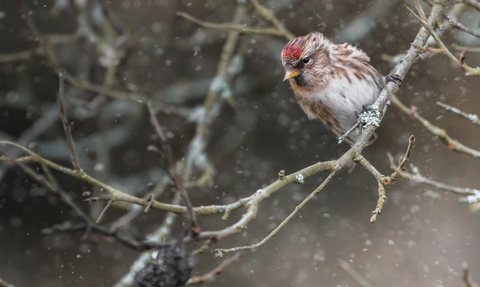
Redpoll in snow - Tom Ellis
Staffordshire in Winter
Winter is a time of subtle beauty and hidden wild treasures to spot.
With leaves and foliage dormant, we can see the stark bare branches of trees, and maybe notice details previously hidden- the variety of texture and colour of tree bark and buds storing up energy for future blooms.
Migratory birds are frequent residents during winter months, and some birds even put on impressive displays called murmurations which help them to keep warm and confuse predators.
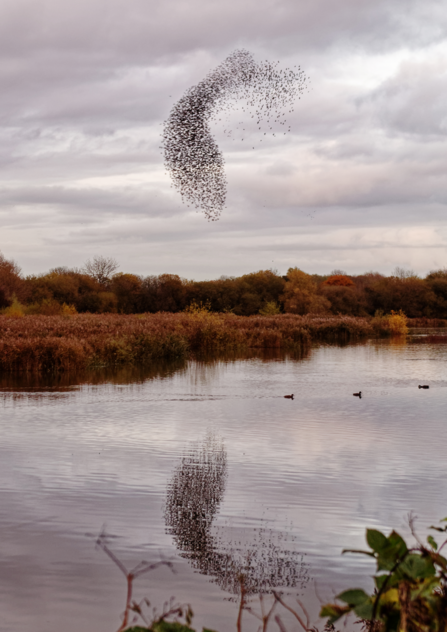
Andy Platts
Bird's in winter
We have now waved goodbye to our high fliers, swallows, swifts and pied flycatchers as they take on their journeys to Europe and Africa. But we are welcoming our whole new foray of winter migratings birds! Redwing, fieldfare, waxwing, rambling, siskins and redpolls are just some of the birds we can expect to see in our gardens or your local nature reserves.
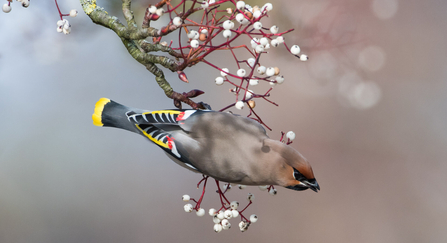
Donald Sutherland
Waxwings are erratic winter visitors in the UK during 'irruption years'. Irruptions occur when the population increases causing food shortages.Waxwings often travel from Scandinavia, through Russia and across the pacific coast in search for food over winter. They are starling sized with an upstanding pointed crest, black throats, black wings with white, yellow and waxy red markisn and yellow tipped tails. They are often seen in groups on berry trees such as rowan, unlike most birds they are often seen in 'unbirdy' locations like city centres, supermarket car parks and out of town shopping areas.
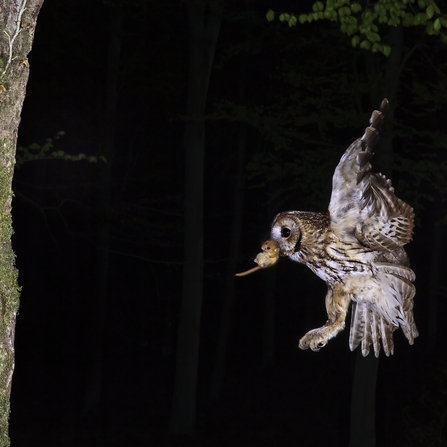
Tawny owl bringing back dormouse to nest © Dale Sutton/2020VISION
Winter is an incredibly important time for our owls of the night. Tawny owls start reinforcing their territory at the beginning of winter and are calling frequently. Courtship feeding takes place from December to February, the male brings extra food to his mate to cement their pair bonding and build up her condition for an early start to breeding season.
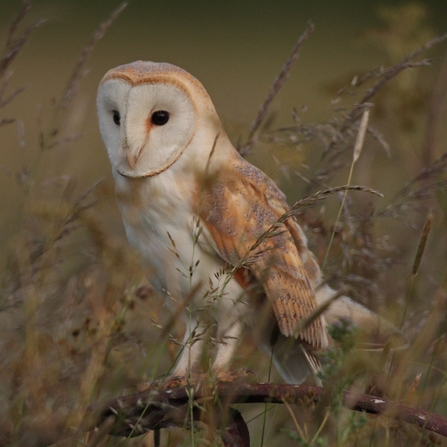
Barn owl © Russell Savory
Barn owls often struggle with winter as their food sources are much scarcer, which often results in barn owls having to hunt in daylight even though they are naturally nocturnal animals. Barn owls are also poorly insulated so they need more food in winter to provide them with enough energy to stay warm. This means they can often be seen hunting from posts and perches to conserve energy rather than flying around.
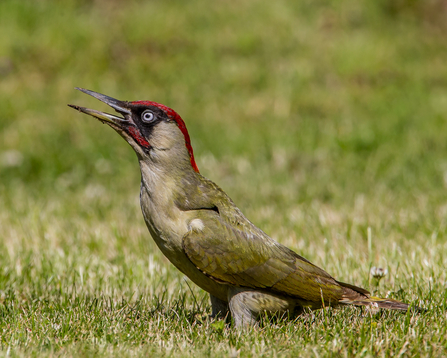
©Andy Morffew
A bird you are more likely to hear before you see them, The green woodpecker is known for its unique call, often referred to as a witch's cackle, laughing or sometimes as yaffling. The green woodpecker is the largest woodpecker in the UK, but also has the weakest beak; this is because they have evolved to eat insects such as ants from anthills and in winter they can often be seen eating apples from orchards. As green woodpeckers don't migrate in winter expect to hear their calls and keep an eye out this winter for them on anthills or in your local orchard.
Our county is also great for wintering wildfowl, sites such as Croxall lakes, Tucklesholme and Doxey marshes are great places to spot these wildfowl. We are lucky to have visited such as wigeon, pochard, northern shovelers, goldeneyes and the water rail and smew on our reserves.
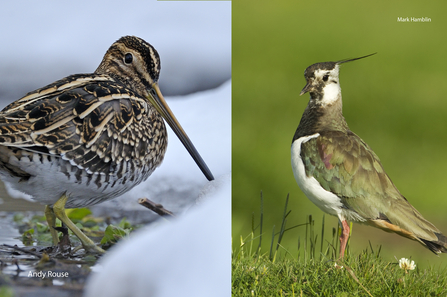
Snipe on the left by Andy Rouse, Lapwing on the right by Mark Hamblin
But don't forget to keep your eyes peeled for snipes rummaging around the edge of wetlands or in the shrubs alongside groups/deceit of lapwings on our wetlands or gathering in grasslands.
Even though we are landlocked we are often visited by Whooper swans and Bewick swans have been seen on Tucklesholme Nature Reserve as they are passing through to coastal areas. Even if we don't have these visitors, great white egrets are often seen towering over the little egrets on our wetlands. We also see bevy's of pink-footed or white-fronted geese flying over or in farmers' fields across Staffordshire.
Mammals in winter
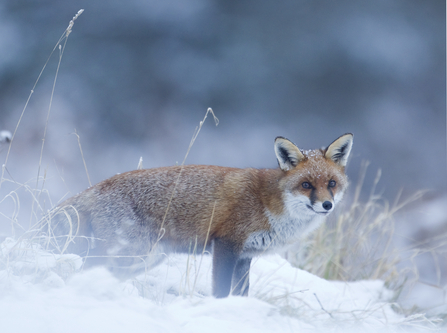
Credit: Danny Green/2020VISION
Almost all mammals in winter will enter hibernation after storing food or fattening up for winter. But some animals like foxes simply become slightly less active as they develop a thicker winter coat. Burrows are not needed until the mating season begins, so it's not uncommon to find a fox sleeping in the open. You can expect to hear the vixen (female fox) scream when mating season has begun towards the end of December right through until the first weeks of March. After their young (kits) are born, the male and female will look after the kits together until they are around six-weeks-old.
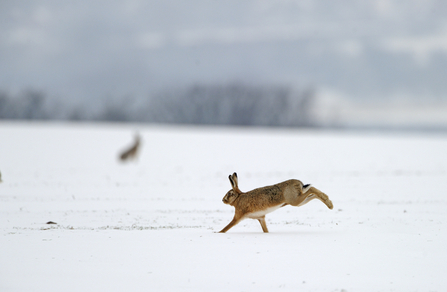
Credit: David Tipling/2020VISION
Brown hares are active all year, unlike rabbits they never dig burrows but rather shallow (under 10cm deep) indents to rest in with just their heads visible. When snow cover increases, it's common to see snowy mounds in open fields, these mounds are sometimes when a hare huddles close to the ground while it's snowing allowing themselves to be encapsulated with snow allowing them to conserve heat. If there is enough snow cover, this reduces grazing, so they sometimes feed on the bark of trees and saplings, so gnaw marks may be visible.
After winter they are readying for March madness! Brown Hares can often be seen ‘boxing’ in the breeding season (March to July). Dominant males will drive competing males away from females. However, most ‘boxing’ is actually undertaken by females seeing off unwanted males.
Sleeping through winter
With the days getting shorter and colder some mammals resort to hibernating through winter. During their deep sleep, a hibernating mammal’s body temperature drops well below the normal 37C, their heartbeat slows to as little as three or four beats per minute, and they breathe only every two minutes or so.
The hedgehog is one of the most well-known hibernators in the UK. In preparation for the dropping temperatures and scarcity of food, they fatten themselves up on slugs, snails and any other grubs they can get their paws on in the autumn, then spends the cold months curled up in a cosy nest of leaves and dry grass. A common misconception though is hedgehogs will sleep all winter. But actually on warmer days, they will awaken and scavenge for food or water.
Bats are also common hibernators, wrapping themselves in their wings deep inside a cave, barn or attic somewhere when the cold hits. Similar to hedgehogs, bats do not hibernate the entire winter, and will venture out to look for food if the temperature rises a little, before returning to their place of rest when the temperature drops again.
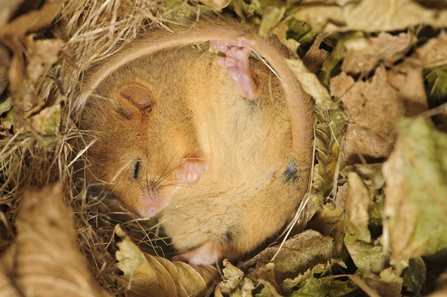
Hazel dormouse (Muscardinus avellanarius), Kent, UK. Credit: Terry Whittaker/2020VISION
The hazel dormouse is the only rodent which hibernates in the UK. These small mammals are also one of the few “true” hibernators, as they sleep from October to April without waking up at all! The little dormouse eats lots of extra food in the autumn, often doubling in weight in the summer months, in anticipation of the stark winter. They build their winter nests on or near the ground, among tree roots or beneath a hedge. While quite scarce in Staffordshire, we do have some small remaining populations of these cute rodents.
With less available light, and more animals hibernating, it may be harder to spot the usual mammal visitors. But with a little luck, and the right weather, you just might see evidence of their visits in the form of tracks on a snowy day.
If you would like to learn how to identify some common animal tracks, head to our dedicated page.





















